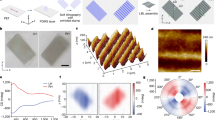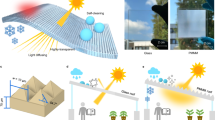Abstract
The efficiency and stability of bifacial perovskite solar modules are still relatively low. Here we report bifacial minimodules with front efficiency comparable to opaque monofacial counterparts, while gaining additional energy from albedo light. We add a hydrophobic additive to the hole transport layer to protect the perovskite films from moisture. We integrate silica nanoparticles with proper size and spacing in perovskite films to recover the absorption loss induced by the absence of reflective metal electrodes. The small-area single-junction bifacial perovskite cells have a power-generation density of 26.4 mW cm−2 under 1 sun illumination and an albedo of 0.2. The bifacial minimodules show front efficiency of over 20% and bifaciality of 74.3% and thus a power-generation density of over 23 mW cm−2 at an albedo of 0.2. The bifacial minimodule retains 97% of its initial efficiency after light soaking under 1 sun for over 6,000 hours at 60 ± 5 °C.
This is a preview of subscription content, access via your institution
Access options
Access Nature and 54 other Nature Portfolio journals
Get Nature+, our best-value online-access subscription
$29.99 / 30 days
cancel any time
Subscribe to this journal
Receive 12 digital issues and online access to articles
$119.00 per year
only $9.92 per issue
Buy this article
- Purchase on Springer Link
- Instant access to full article PDF
Prices may be subject to local taxes which are calculated during checkout




Similar content being viewed by others
Data availability
All data generated or analysed during this study are included in the published article and its supplementary information. Source data are provided with this paper.
References
Best Research-Cell Efficiency Chart (NREL, 2023); https://www.nrel.gov/pv/cell-efficiency.html
Min, H. et al. Perovskite solar cells with atomically coherent interlayers on SnO2 electrodes. Nature 598, 444–450 (2021).
Li, Z. et al. Organometallic-functionalized interfaces for highly efficient inverted perovskite solar cells. Science 376, 416–420 (2022).
Azmi, R. et al. Damp heat stable perovskite solar cells with tailored-dimensionality 2D/3D heterojunctions. Science 376, 73–77 (2022).
Zhao, X. et al. Accelerated aging of all-inorganic, interface-stabilized perovskite solar cells. Science 377, 307–310 (2022).
Bella, F. et al. Improving efficiency and stability of perovskite solar cells with photocurable fluoropolymers. Science 354, 203–206 (2016).
Yang, S. et al. Stabilizing halide perovskite surfaces for solar cell operation with wide-bandgap lead oxysalts. Science 365, 473–478 (2019).
Bai, S. et al. Planar perovskite solar cells with long-term stability using ionic liquid additives. Nature 571, 245–250 (2019).
Ku, Z., Rong, Y., Xu, M., Liu, T. & Han, H. Full printable processed mesoscopic CH3NH3PbI3/TiO2 heterojunction solar cells with carbon counter electrode. Sci. Rep. 3, 3132 (2013).
Park, N.-G. & Zhu, K. Scalable fabrication and coating methods for perovskite solar cells and solar modules. Nat. Rev. Mater. 5, 333–350 (2020).
Kim, M. et al. Conformal quantum do SnO2 layers as electron transporters for efficient perovskite solar cells. Science 375, 302–306 (2022).
Deng, Y. et al. Defect compensation in formamidinium–caesium perovskites for highly efficient solar mini-modules with improved photostability. Nat. Energy 6, 633–641 (2021).
Chen, S. et al. Stabilizing perovskite–substrate interfaces for high-performance perovskite modules. Science 373, 902–907 (2021).
Bu, T. et al. Lead halide templated crystallization of methylamine-free perovskite for efficient photovoltaic modules. Science 372, 1327–1332 (2021).
Deng, Y. et al. Surfactant-controlled ink drying enables high-speed deposition of perovskite films for efficient photovoltaic modules. Nat. Energy 3, 560–566 (2018).
Yoo, J. W. et al. Efficient perovskite solar mini-modules fabricated via bar-coating using 2-methoxyethanol-based formamidinium lead tri-iodide precursor solution. Joule 5, 2420–2436 (2021).
Yang, Z. et al. Slot-die coating large-area formamidinium-cesium perovskite film for efficient and stable parallel solar module. Sci. Adv. 7, eabg3749 (2021).
Hiroshi, M. Radiation Energy Transducing Device. US patent US3278811A (1966).
Hübner, A., Aberle, A. G. & Hezel, R. Novel cost-effective bifacial silicon solar cells with 19.4% front and 18.1% rear efficiency. Appl. Phys. Lett. 70, 1008–1010 (1997).
Guerrero-Lemus, R., Vega, R., Kim, T., Kimm, A. & Shephard, L. Bifacial solar photovoltaics–a technology review. Renew. Sust. Energy Rev. 60, 1533–1549 (2016).
Seo Y, et al. Effect of front irradiance and albedo on bifacial gain in 1.8 kW bifacial silicon photovoltaic system. In 2019 IEEE 46th Photovoltaic Specialists Conference (PVSC), 1298–1301 (IEEE, 2019).
Liang, T. S. et al. A review of crystalline silicon bifacial photovoltaic performance characterisation and simulation. Energy Environ. Sci. 12, 116–148 (2019).
Bifacial Solar Market Research Report (Market Research Future, 2023); https://www.marketresearchfuture.com/reports/bifacial-solar-market-10149
Albedo data for bifacial PV systems—dataset. DuraMAT https://datahub.duramat.org/project/albedo-study
Marion, B. Albedo data sets for bifacial PV systems. In 2020 47th IEEE Photovoltaic Specialists Conference (PVSC), 0485–0489 (IEEE, 2020).
Park, H., Chang, S., Park, S. & Kim, W. K. Outdoor performance test of bifacial n-type silicon photovoltaic modules. Sustainability 11, 6234 (2019).
Muehleisen, W. et al. Energy yield measurement of an elevated PV system on a white flat roof and a performance comparison of monofacial and bifacial modules. Renew. Energy 170, 613–619 (2021).
Stein, J.S. et al. Outdoor field performance from bifacial photovoltaic modules and systems. In Conference Record of the IEEE Photovoltaic Specialists Conference, 2017, 3184–3189 (IEEE, 2017).
Hanmandlu, C. et al. Bifacial perovskite solar cells featuring semitransparent electrodes. ACS Appl. Mater. Interfaces 9, 32635–32642 (2017).
Song, Z. et al. Assessing the true power of bifacial perovskite solar cells under concurrent bifacial illumination. Sustain Energy Fuels 5, 2865–2870 (2021).
Song, Z., Li, C., Chen, L. & Yan, Y. Perovskite solar cells go bifacial—mutual benefits for efficiency and durability. Adv. Mater. 34, 2106805 (2022).
Kim, S. et al. Over 30% efficiency bifacial 4-terminal perovskite-heterojunction silicon tandem solar cells with spectral albedo. Sci. Rep. 11, 15524 (2021).
Zhang, C. et al. CNT-based bifacial perovskite solar cells toward highly efficient 4-terminal tandem photovoltaics. Energy Environ. Sci. 15, 1536–1544 (2022).
De Bastiani, M. et al. Efficient bifacial monolithic perovskite/silicon tandem solar cells via bandgap engineering. Nat. Energy 6, 167–175 (2021).
Chen, B. et al. Bifacial all-perovskite tandem solar cells. Sci. Adv. 8, eadd0377 (2022).
Albrecht, S. et al. Monolithic perovskite/silicon-heterojunction tandem solar cells processed at low temperature. Energy Environ. Sci. 9, 81–88 (2016).
Bush, K. A. et al. Thermal and environmental stability of semi‐transparent perovskite solar cells for tandems enabled by a solution‐processed nanoparticle buffer layer and sputtered ITO electrode. Adv. Mater. 28, 3937–3943 (2016).
Bush, K. A. et al. 23.6%-efficient monolithic perovskite/silicon tandem solar cells with improved stability. Nat. Energy 2, 17009 (2017).
Tepner, S. et al. Screen pattern simulation for an improved front‐side Ag‐electrode metallization of Si-solar cells. Prog. Photovolt. Res. Appl. 28, 1054–1062 (2020).
Fu, W. et al. Tailoring the functionality of organic spacer cations for efficient and stable quasi-2D perovskite solar cells. Adv. Funct. Mater. 29, 1900221 (2019).
Wu, W. Q., Rudd, P. N., Wang, Q., Yang, Z. & Huang, J. Blading phase‐pure formamidinium‐alloyed perovskites for high-efficiency solar cells with low photovoltage deficit and improved stability. Adv. Mater. 32, 2000995 (2020).
Ye, T. et al. Enhanced efficiency of planar heterojunction perovskite solar cells by a light soaking treatment on tris (pentafluorophenyl) borane-doped poly (triarylamine) solution. ACS Appl. Mater. Interfaces 11, 14004–14010 (2019).
Yurash, B. et al. Towards understanding the doping mechanism of organic semiconductors by Lewis acids. Nat. Mater. 18, 1327–1334 (2019).
Gu, H. et al. Construction of three-dimensional ordered porous carbon bulk networks for high performance lithium-sulfur batteries. J. Colloid Interface Sci. 533, 445–451 (2019).
Stöber, W., Fink, A. & Bohn, E. Controlled growth of monodisperse silica spheres in the micron size range. J. Colloid Interface Sci. 26, 62–69 (1968).
Peng, J. et al. Nanoscale localized contacts for high fill factors in polymer-passivated perovskite solar cells. Science 371, 390–395 (2021).
Palik, E.D. Handbook of Optical Constants of Solids (Academic Press, 1998).
Konig, T. A. et al. Electrically tunable plasmonic behavior of nanocube–polymer nanomaterials induced by a redox-active electrochromic polymer. ACS Nano 8, 6182–6192 (2014).
Acknowledgements
We thank the University of North Carolina at Chapel Hill for financial support. This work was performed in part at the Chapel Hill Analytical and Nanofabrication Laboratory, CHANL, supported by the National Science Foundation grant ECCS-2025064. XPS characterization was supported in part by the Center for Hybrid Approaches in Solar Energy to Liquid Fuels (CHASE), an Energy Innovation Hub funded by the US Department of Energy, Office of Basic Energy Sciences under award number DE-SC0021173.
Author information
Authors and Affiliations
Contributions
J.H. and H.G. conceived the idea. H.G., M.A.U., C.F. and W.X. prepared blade-coating inks. H.G. fabricated perovskite bifacial solar cells and modules. Z.N. and G.Y carried out PL intensity, TRPL and PL mapping measurements. G.Y. optimized the ALD SnO2 buffer-layer growth parameters. B.C. optimized the ITO deposition parameters and measured the contact angle. H.G. and H.Z. performed XRD measurements. H.G. and H.J. studied the decay mechanism of the perovskite module. Z.Y. performed FDTD simulation of light scattering. H.G., J.H. and Z.Y. wrote the paper, and all authors reviewed the paper.
Corresponding author
Ethics declarations
Competing interests
The authors declare no competing interests.
Peer review
Peer review information
Nature Energy thanks Zhaoning Song and the other, anonymous, reviewer(s) for their contribution to the peer review of this work.
Additional information
Publisher’s note Springer Nature remains neutral with regard to jurisdictional claims in published maps and institutional affiliations.
Supplementary information
Supplementary Information
Supplementary Notes 1 and 2, Tables 1–6 and Figs. 1–37.
Supplementary Data
Source data for Supplementary Fig. 7.
Source data
Source Data Fig. 3
Statistical source data.
Source Data Fig. 4
Statistical source data.
Rights and permissions
Springer Nature or its licensor (e.g. a society or other partner) holds exclusive rights to this article under a publishing agreement with the author(s) or other rightsholder(s); author self-archiving of the accepted manuscript version of this article is solely governed by the terms of such publishing agreement and applicable law.
About this article
Cite this article
Gu, H., Fei, C., Yang, G. et al. Design optimization of bifacial perovskite minimodules for improved efficiency and stability. Nat Energy 8, 675–684 (2023). https://doi.org/10.1038/s41560-023-01254-3
Received:
Accepted:
Published:
Issue Date:
DOI: https://doi.org/10.1038/s41560-023-01254-3
This article is cited by
-
High-performance bifacial perovskite solar cells enabled by single-walled carbon nanotubes
Nature Communications (2024)
-
Mobile iodides capture for highly photolysis- and reverse-bias-stable perovskite solar cells
Nature Materials (2024)
-
Rapid advances enabling high-performance inverted perovskite solar cells
Nature Reviews Materials (2024)
-
Modulation of perovskite degradation with multiple-barrier for light-heat stable perovskite solar cells
Nature Communications (2023)



